Second Homework- correction
作业批改中存在的问题及解决对策
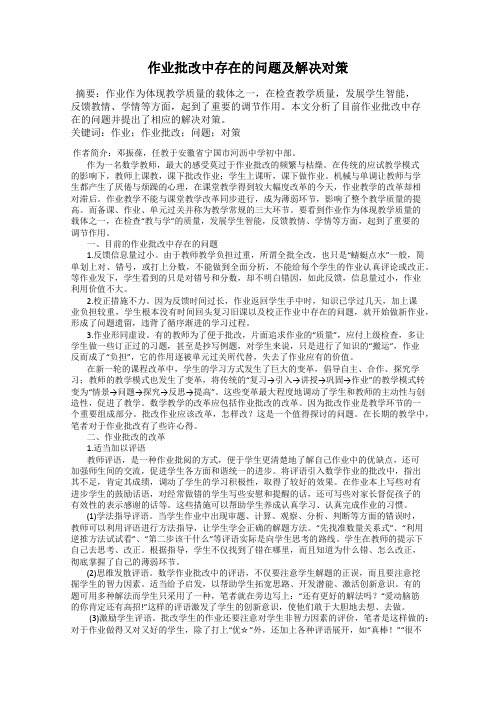
作业批改中存在的问题及解决对策摘要:作业作为体现教学质量的载体之一,在检查教学质量,发展学生智能,反馈教情、学情等方面,起到了重要的调节作用。
本文分析了目前作业批改中存在的问题并提出了相应的解决对策。
关键词:作业;作业批改;问题;对策作者简介:邓振葆,任教于安徽省宁国市河沥中学初中部。
作为一名数学教师,最大的感受莫过于作业批改的频繁与枯燥。
在传统的应试教学模式的影响下,教师上课教,课下批改作业;学生上课听,课下做作业。
机械与单调让教师与学生都产生了厌倦与烦躁的心理,在课堂教学得到较大幅度改革的今天,作业教学的改革却相对滞后。
作业教学不能与课堂教学改革同步进行,成为薄弱环节,影响了整个教学质量的提高。
而备课、作业、单元过关并称为教学常规的三大环节。
要看到作业作为体现教学质量的载体之一,在检查“教与学”的质量,发展学生智能,反馈教情、学情等方面,起到了重要的调节作用。
一、目前的作业批改中存在的问题1.反馈信息量过小。
由于教师教学负担过重,所谓全批全改,也只是“蜻蜓点水”一般,简单划上对、错号,或打上分数,不能做到全面分析,不能给每个学生的作业认真评论或改正。
等作业发下,学生看到的只是对错号和分数,却不明白错因,如此反馈,信息量过小,作业利用价值不大。
2.校正措施不力。
因为反馈时间过长,作业返回学生手中时,知识已学过几天,加上课业负担较重,学生根本没有时间回头复习旧课以及校正作业中存在的问题,就开始做新作业,形成了问题遗留,违背了循序渐进的学习过程。
3.作业形同虚设。
有的教师为了便于批改,片面追求作业的“质量”,应付上级检查,多让学生做一些订正过的习题,甚至是抄写例题,对学生来说,只是进行了知识的“搬运”,作业反而成了“负担”,它的作用逐被单元过关所代替,失去了作业应有的价值。
在新一轮的课程改革中,学生的学习方式发生了巨大的变革,倡导自主、合作、探究学习;教师的教学模式也发生了变革,将传统的“复习→引入→讲授→巩固→作业”的教学模式转变为“情景→问题→探究→反思→提高”。
加强作业管理优化作业评价

加强作业管理优化作业评价加强作业管理优化作业评价摘要:随着教育改革的不断推进,作业作为一种重要的教学手段和学习方式,对于学生的学习效果有着重要的影响。
然而,当前的作业管理和作业评价存在一定的问题,如作业负担过重、评价体系单一等,导致了学生的学习兴趣下降和学习效果不佳。
本文通过对作业管理和作业评价的优化措施的分析与总结,提出了加强作业管理和优化作业评价的策略,以提高学生的学习积极性和学习效果。
一、绪论作业是教师与学生之间的桥梁,能够巩固学生的知识,提高学生的能力。
作业管理是对作业的布置、批改、分析与反馈等环节进行有效的管理,而作业评价则是对学生作业完成情况进行的评估。
优化作业管理和作业评价是提高教学质量的关键所在。
二、问题分析与原因1. 作业负担过重当前学生的作业负担普遍过重,压力巨大。
长时间的做作业会让学生心理疲惫,无法专注于学习。
2. 评价体系单一目前的作业评价体系主要依靠分数评价,忽视了学生的兴趣、动机等因素,无法全面评价学生的学习情况。
三、加强作业管理的策略1. 合理安排作业量教师应根据学生的实际情况,合理安排作业量,使学生能够在适当的时间内完成,减轻学生的作业负担。
2. 鼓励学生思考和创新作业不仅仅是记忆和重复,更应该注重学生的思考和创新能力的培养,通过设计开放性问题和实践性作业等方式,激发学生的学习兴趣。
3. 加强作业反馈教师应及时对学生的作业进行批改,并给予针对性的反馈,帮助学生发现自己的不足,及时纠正错误。
四、优化作业评价的策略1. 多元化的评价方式除了传统的笔试、口试等方式外,可以引入项目制作、实践操作等方式进行评价,更能体现学生的综合能力和个性特点。
2. 给予针对性的评价信息作业评价不仅仅是给予分数,还应给予学生具体的评价信息,指导学生学习和提高自己的不足之处。
3. 培养学生的自我评价意识鼓励学生对自己的学习进行评价,并提供学习反思的机会,帮助学生提高自主学习能力。
五、结论加强作业管理和优化作业评价是提高学生学习效果的重要手段。
写作业常用英语翻译

写作业常用英语翻译1. 完成作业 - "Finish the homework"2. 提交作业 - "Submit the assignment"3. 作业截止日期 - "Homework deadline"4. 作业批改 - "Homework correction"5. 作业检查 - "Homework review"6. 家庭作业 - "Homework"7. 课堂作业 - "Classwork"8. 练习题 - "Exercises"9. 作业本 - "Homework book"10. 作业量 - "Amount of homework"11. 作业帮助 - "Homework help"12. 作业指导 - "Homework guidance"13. 作业答案 - "Homework answers"14. 作业题目 - "Homework questions"15. 作业进度 - "Homework progress"16. 作业清单 - "Homework checklist"17. 作业评分 - "Homework grading"18. 作业要求 - "Homework requirements"19. 作业完成情况 - "Homework completion status"20. 作业讨论 - "Homework discussion"21. 作业反馈 - "Homework feedback"22. 作业延期 - "Homework extension"23. 作业提交 - "Homework submission"24. 作业笔记 - "Homework notes"25. 作业计划 - "Homework schedule"。
剑桥雅思阅读8原文翻译及答案(test4)
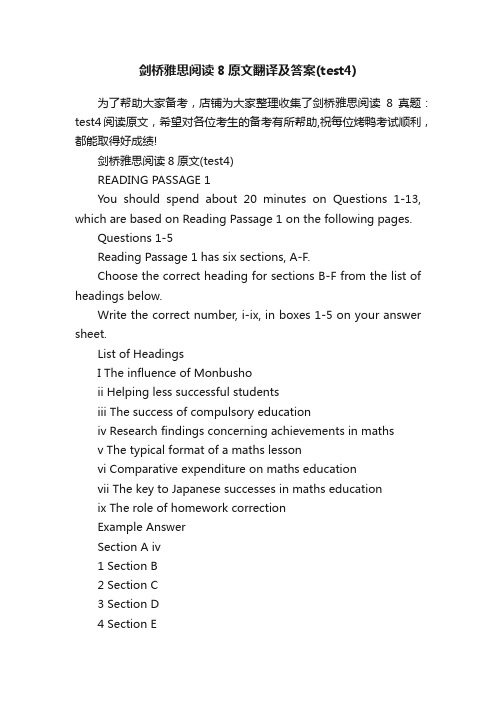
剑桥雅思阅读8原文翻译及答案(test4)为了帮助大家备考,店铺为大家整理收集了剑桥雅思阅读8真题:test4阅读原文,希望对各位考生的备考有所帮助,祝每位烤鸭考试顺利,都能取得好成绩!剑桥雅思阅读8原文(test4)READING PASSAGE 1You should spend about 20 minutes on Questions 1-13, which are based on Reading Passage 1 on the following pages.Questions 1-5Reading Passage 1 has six sections, A-F.Choose the correct heading for sections B-F from the list of headings below.Write the correct number, i-ix, in boxes 1-5 on your answer sheet.List of HeadingsI The influence of Monbushoii Helping less successful studentsiii The success of compulsory educationiv Research findings concerning achievements in mathsv The typical format of a maths lessonvi Comparative expenditure on maths educationvii The key to Japanese successes in maths educationix The role of homework correctionExample AnswerSection A iv1 Section B2 Section C3 Section D4 Section E5 Section FLAND OF THE RISING SUMA Japan has a significantly better record in terms of average mathematical attainment than England and Wales. Large sample international comparisons of pupils’ attainments since the 1960s have established that not only did Japanese pupils at age13 have better scores of average attainment, but there was alsoa larger proportion of ‘low’ attainers in England, where, incidentally, the variation in attainment scores was much greater. The percentage of Gross National Product spent on education is reasonably similar in the two countries, so how is this higher and more consistent attainment in maths achieved?B Lower secondary schools in Japan cover three school years, from the seventh grade (age 13) to the ninth grade (age 15). Virtually all pupils at this stage attend state schools: only 3 per cent are in the private sector. Schools are usually modern in design, set well back from the road and spacious inside. Classrooms are large and pupils sit at single desks in rows. Lessons last for a standardised 50 minutes and are always followed by a 10-minute break, which gives the pupils a chance to let off steam. Teachers begin with a formal address and mutual bowing, and then concentrate on whole-class teaching.Classes are large — usually about 40 — and are unstreamed. Pupils stay in the same class for all lessons throughout the school and develop considerable class identity and loyalty. Pupils attend the school in their own neighbourhood, which in theory removes ranking by school. In practice in T okyo, because of the relative concentration of schools, there is some competition to get into the ‘better’ school in a particular area.C Traditional ways of teaching form the basis of the lessonand the remarkably quiet classes take their own notes of the points made and the examples demonstrated. Everyone has their own copy of the textbook supplied by the central education authority, Monbusho, as part of the concept of free compulsory education up to the age of 15. These textbooks are, on the whole, small, presumably inexpensive to produce, but well set out and logically developed. (One teacher was particularly keen to introduce colour and pictures into maths textbooks: he felt this would make them more accessible to pupils brought up in a cartoon culture.) Besides approving textbooks, Monbusho also decides the highly centralised national curriculum and how it is to be delivered.D Lessons all follow the same pattern. At the beginning, the pupils put solutions to the homework on the board, then the teachers comment, correct or elaborate as necessary. Pupils mark their own homework: this is an important principle in Japanese schooling as it enables pupils to see where and why they made a mistake, so that these can be avoided in future. No one minds mistakes or ignorance as long as you are prepared to learn from them.After the homework has been discussed, the teacher explains the topic of the lesson, slowly and with a lot of repetition and elaboration. Examples are demonstrated on the board; questions from the textbook are worked through first with the class, and then the class is set questions from the textbook to do individually. Only rarely are supplementary worksheets distributed in a maths class. The impression is that the logical nature of the textbooks and their comprehensive coverage of different types of examples, combined with the relative homogeneity of the class, renders work sheets unnecessary. Atthis point, the teacher would circulate and make sure that all the pupils were coping well.E It is remarkable that large, mixed-ability classes could be kept together for maths throughout all their compulsory schooling from 6 to 15. Teachers say that they give individual help at the end of a lesson or after school, setting extra work if necessary. In observed lessons, any strugglers would be assisted by the teacher or quietly seek help from their neighbour. Carefully fostered class identity makes pupils keen to help each other — anyway, it is in their interests since the class progresses together.This scarcely seems adequate help to enable slow learners to keep up. However, the Japanese attitude towards education runs along the lines of ‘if you work hard enough, you can do almost anything’. Parents are kept closely informed of their children’s progress and will play a part in helping their children to keep up with class, s ending them to ‘Juku’ (private evening tuition) if extra help is needed and encouraging them to work harder. It seems to work, at least for 95 per cent of the school population.F So what are the major contributing factors in the success of maths teaching? Clearly, attitudes are important. Education is valued greatly in Japanese culture; maths is recognised as an important compulsory subject throughout schooling; and the emphasis is on hard work coupled with a focus on accuracy.Other relevant points relate to the supportive attitude of a class towards slower pupils, the lack of competition within a class, and the positive emphasis on learning for oneself and improving one’s own standard. And the view of repetitively boring lessons and learning the facts by heart, which is sometimes quoted in relation to Japanese classes, may be unfair and unjustified. Nopoor maths lessons were observed. They were mainly good and one or two were inspirational.Questions 6-9Do the following statements agree with the claims of the writer in Reading Passage 1?In boxes 6-9 on your answer sheet, writeYES if the statement agrees with the claims of the writerNO if the statement contradicts the claims of the writerNOT GIVEN if it is impossible to say what the writer thinks about this6 There is a wider range of achievement amongst English pupils studying maths than amongst their Japanese counterparts.7 The percentage of Gross National Product spent on education generally reflects the level of attainment in mathematics.8 Private schools in Japan are more modern and spacious than state-run lower secondary schools.9 Teachers mark homework in Japanese schools.Questions 10-13Choose the correct letter, A, B, C or D.Write the correct letter in boxes 10-13 on your answer sheet.10 Maths textbooks in Japanese schools areA cheap for pupils to buyB well organized and adapted to the needs of the pupils.C written to be used in conjunction with TV programmes.D not very popular with many Japanese teachers.11 When a new maths topic is introduced,A students answer questions on the board.B students rely entirely on the textbook.C it is carefully and patiently explained to the students.D it is usual for students to use extra worksheets.12 How do schools deal with students who experience difficulties?A They are given appropriate supplementary tuition.B They are encouraged to copy from other pupils.C They are forced to explain their slow progress.D They are placed in a mixed-ability class.13 Why do Japanese students tend to achieve relatively high rates of success in maths?A It is a compulsory subject in Japan.B They are used to working without help from others.C Much effort is made and correct answers are emphasized.D there is a strong emphasis on repetitive learning.READING PASSAGE 2You should spend about 20 minutes on Questions 14-26, which are based on Reading Passage 2 below.Biological control of pestsThe continuous and reckless use of synthetic chemicals for the control of pests which pose a threat to agricultural crops and human health is proving to be counter-productive. Apart from engendering widespread ecological disorders, pesticides have contributed to the emergence of a new breed of chemical-resistant, highly lethal superbugs.According to a recent study by the Food and Agriculture Organisation (FAO), more than 300 species of agricultural pests have developed resistance to a wide range of potent chemicals. Not to be left behind are the disease-spreading pests, about 100 species of which have become immune to a variety of insecticides now in use.One glaring disadvantage of pesticides’ application is that,while destroying harmful pests, they also wipe out many useful non-targeted organisms, which keep the growth of the pest population in check. This results in what agroecologists call the ‘treadmill syndrome’. Because of their tremendous breeding potential and genetic diversity, many pests are known to withstand synthetic chemicals and bear offspring with a built-in resistance to pesticides.The havoc that the ‘treadmill syndrome’ can bring about is well illustrated by what happened to cotton farmers in Central America. In the early 1940s, basking in the glory of chemical-based intensive agriculture, the farmers avidly took to pesticides as a sure measure to boost crop yield. The insecticide was applied eight times a year in the mid-1940s, rising to 28 in a season in the mid-1950s, following the sudden proliferation of three new varieties of chemical-resistant pests.By the mid-1960s, the situation took an alarming turn with the outbreak of four more new pests, necessitating pesticide spraying to such an extent that 50% of the financial outlay on cotton production was accounted for by pesticides. In the early 1970s, the spraying frequently reached 70 times a season as the farmers were pushed to the wall by the invasion of genetically stronger insect species.Most of the pesticides in the market today remain inadequately tested for properties that cause cancer and mutations as well as for other adverse effects on health, says a study by United States environmental agencies. The United States National Resource Defense Council has found that DDT was the most popular of a long list of dangerous chemicals in use.In the face of the escalating perils from indiscriminate applications of pesticides, a more effective and ecologicallysound strategy of biological control, involving the selective use of natural enemies of the pest population, is fast gaining popularity — though, as yet, it is a new field with limited potential. The advantage of biological control in contrast to other methods is that it provides a relatively low-cost, perpetual control system with a minimum of detrimental side-effects. When handled by experts, bio-control is safe, non-polluting and self-dispersing.The Commonwealth Institute of Biological Control (CIBC) in Bangalore, with its global network of research laboratories and field stations, is one of the most active, non-commercial research agencies engaged in pest control by setting natural predators against parasites. CIBC also serves as a clearing-house for the export and import of biological agents for pest control world-wide.CIBC successfully used a seed-feeding weevil, native to Mexico, to control the obnoxious parthenium weed, known to exert devious influence on agriculture and human health in both India and Australia. Similarly the Hyderabad-based Regional Research Laboratory (RRL), supported by CIBC, is now trying out an Argentinian weevil for the eradication of water hyacinth, another dangerous weed, which has become a nuisance in many parts of the world. According to Mrs Kaiser Jamil of RRL, ‘The Argentinian weevil does not attack any other plant and a pair of adult bugs could destroy the weed in 4-5 days.’ CIBC is also perfecting the technique for breeding parasites that prey on ‘disapene scale’ insects — notorious defoliants of fruit trees in the US and India.How effectively biological control can be pressed into service is proved by the following examples. In the late 1960s, when Sri Lanka’s flouri shing coconut groves were plagued by leaf-mininghispides, a larval parasite imported from Singapore brought the pest under control. A natural predator indigenous to India, Neodumetia sangawani, was found useful in controlling the Rhodes grass-scale insect that was devouring forage grass in many parts of the US. By using Neochetina bruci, a beetle native to Brazil, scientists at Kerala Agricultural University freed a 12-kilometre-long canal from the clutches of the weed Salvinia molesta, popularly called ‘African Payal’ in Kerala. About 30,000 hectares of rice fields in Kerala are infested by this weed.Questions 14-17Choose the correct letter, A, B, C, or D.Write the correct letter in boxes 14-17 on your answer sheet.14 The use of pesticides has contributed toA a change in the way ecologies are classified by agroecologists.B an imbalance in many ecologies around the world .C the prevention of ecological disasters in some parts of the the world .D an increase in the range of ecologies which can be usefully farmed.15 The Food and Agriculture Organisation has counted more than 300 agricultural pests whichA are no longer responding to most pesticides in use.B can be easily controlled through the use of pesticides.C continue to spread disease in a wide range of crops.D may be used as part of bio-control’s replacement of pesticides.16 Cotton farmers in Central America began to use pesticidesA because of an intensive government advertising campaign.B in response to the appearance of new varieties of pest.C as a result of changes in the seasons and the climate.D to ensure more cotton was harvested from each crop.17 By the mid-1960s, cotton farmers in Central America found that pesticidesA were wiping out 50% of the pests plaguing the crops.B were destroying 50% of the crop they were meant to protect.C were causing a 50% increase in the number of new pests reported.D were costing 50% of the total amount they spent on their crops.Questions 18-21Do the following statements agree with the claims of the writer in Reading Passage 2?In boxes 18-21 on your answer sheet, writeYES if the statement agrees with the claims of the writerNo if the statement contradicts the claims of the writerNOT GIVEN if it impossible to say what the write thinks about this18 Disease-spreading pests respond more quickly to pesticides than agricultural pests do.19 A number of pests are now born with an innate immunity to some pesticides.20 Biological control entails using synthetic chemicals to try and change the genetic make-up of the pests’ offspring.21 Bio-control is free from danger under certain circumstances.Questions 22-26Complete each sentence with the correct ending, A-I, below.Write the correct letter, A-I, in boxes 22-26 on your answersheet.22 Disapene scale insects feed on23 Neodumetia sangawani ate24 Leaf-mining hispides blighted25 An Argentinian weevil may be successful in wiping out26 Salvinia molesta plaguesA forage grass.B rice fields.C coconut trees.D fruit trees.E water hyacinth.F parthenium weed.G Brazilian beetles.H grass-scale insects.I larval parasites.READING PASSAGE 3You should spend about 20 minutes on Questions 27-40, which are based on Reading Passage 3 below.Collecting Ant SpecimensCollecting ants can be as simple as picking up stray ones and placing them in a glass jar, or as complicated as completing an exhaustive survey of all species present in an area and estimating their relative abundances. The exact method used will depend on the final purpose of the collections. For taxonomy, or classification, long series, from a single nest, which contain all castes (workers, including majors and minors, and, if present, queens and males) are desirable, to allow the determination of variation within species. For ecological studies, the most important factor is collecting identifiable samples of as many of the different species present as possible. Unfortunately, thesemethods are not always compatible. The taxonomist sometimes overlooks whole species in favour of those groups currently under study, while the ecologist often collects only a limited number of specimens of each species, thus reducing their value for taxonomic investigations.To collect as wide a range of species as possible, several methods must be used. These include hand collecting, using baits to attract the ants, ground litter sampling, and the use of pitfall traps. Hand collecting consists of searching for ants everywhere they are likely to occur. This includes on the ground, under rocks, logs or other objects on the ground, in rotten wood on the ground or on trees, in vegetation, on tree trunks and under bark. When possible, collections should be made from nests or foraging columns and at least 20 to 25 individuals collected. This will ensure that all individuals are of the same species, and so increase their value for detailed studies. Since some species are largely nocturnal, collecting should not be confined to daytime. Specimens are collected using an aspirator (often called a pooter), forceps, a fine, moistened paint brush, or fingers, if the ants are known not to sting. Individual insects are placed in plastic or glass tubes (1.5-3.0 ml capacity for small ants, 5-8 ml for larger ants) containing 75% to 95% ethanol. Plastic tubes with secure tops are better than glass because they are lighter, and do not break as easily if mishandled.Baits can be used to attract and concentrate foragers. This often increases the number of individuals collected and attracts species that are otherwise elusive. Sugars and meats or oils will attract different species and a range should be utilised. These baits can be placed either on the ground or on the trunks of trees or large shrubs. When placed on the ground, baits should besituated on small paper cards or other flat, light-coloured surfaces, or in test-tubes or vials. This makes it easier to spot ants and to capture them before they can escape into the surrounding leaf litter.Many ants are small and forage primarily in the layer of leaves and other debris on the ground. Collecting these species by hand can be difficult. One of the most successful ways to collect them is to gather the leaf litter in which they are foraging and extract the ants from it. This is most commonly done by placing leaf litter on a screen over a large funnel, often under some heat. As the leaf litter dries from above, ants (and other animals) move downward and eventually fall out the bottom and are collected in alcohol placed below the funnel. This method works especially well in rain forests and marshy areas. A method of improving the catch when using a funnel is to sift the leaf litter through a coarse screen before placing it above the funnel. This will concentrate the litter and remove larger leaves and twigs. It will also allow more litter to be sampled when using a limited number of funnels.The pitfall trap is another commonly used tool for collecting ants. A pitfall trap can be any small container placed in the ground with the top level with the surrounding surface and filled with a preservative. Ants are collected when they fall into the trap while foraging. The diameter of the traps can vary from about 18 mm to 10 cm and the number used can vary- from a few to several hundred. The size of the traps used is influenced largely by personal preference (although larger sizes are generally better), while the number will be determined by the study being undertaken. The preservative used is usually ethylene glycol or propylene glycol, as alcohol will evaporate quickly and the trapswill dry out. One advantage of pitfall traps is that they can be used to collect over a period of time with minimal maintenance and intervention. One disadvantage is that some species are not collected as they either avoid the traps or do not commonly encounter them while foraging.Questions 27-30Do the following statements agree with the information given in Reading Passage 3?In boxes 27-30 on your answer sheet, writeTRUE if the statement agrees with the informationFALSE if the statement contradicts the informationNOT GIVEN if there is no information on this27 Taxonomic research involves comparing members of one group of ants.28 New species of ants are frequently identified by taxonomists.29 Range is the key criterion for ecological collections.30 A single collection of ants can generally be used for both taxonomic and ecological purposes.Questions 31-36Classify the following statements as referring toA hand collectingB using baitC sampling ground litterD using a pitfall trapWrite the correct letter, A,B,C or D, in boxes 31-36 on your answer sheet.31 It is preferable to take specimens from groups of ants.32 It is particularly effective for wet habitats.33 It is a good method for species which are hard to find.34 Little time and effort is required.35 Separate containers are used for individual specimens.36 Non-alcoholic preservative should be used.Questions 37-40Label the diagram below.Choose NO MORE THAN TWO WORDS from the passage for each answer.Write your answers in boxes 37-40 on your answer sheet.剑桥雅思阅读8原文参考译文(test4)PASSAGE 1 参考译文:数学崛起之地A.就数学的平均成绩而言,日本的纪录要比英格兰和威尔士好得多。
关于课后给学生补家庭作业的建议英文作文
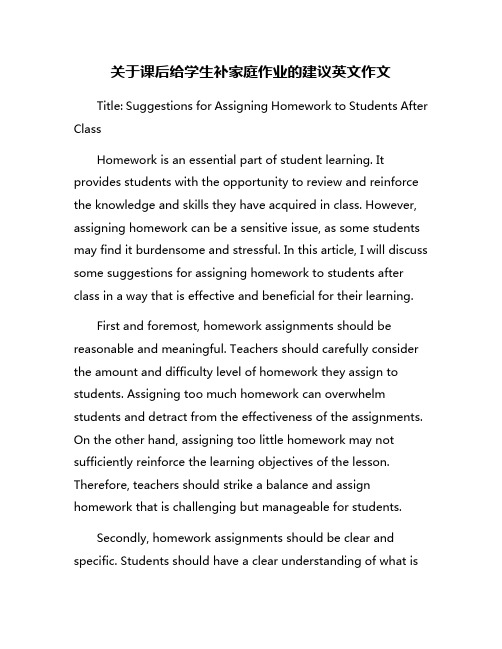
关于课后给学生补家庭作业的建议英文作文Title: Suggestions for Assigning Homework to Students After ClassHomework is an essential part of student learning. It provides students with the opportunity to review and reinforce the knowledge and skills they have acquired in class. However, assigning homework can be a sensitive issue, as some students may find it burdensome and stressful. In this article, I will discuss some suggestions for assigning homework to students after class in a way that is effective and beneficial for their learning.First and foremost, homework assignments should be reasonable and meaningful. Teachers should carefully consider the amount and difficulty level of homework they assign to students. Assigning too much homework can overwhelm students and detract from the effectiveness of the assignments. On the other hand, assigning too little homework may not sufficiently reinforce the learning objectives of the lesson. Therefore, teachers should strike a balance and assign homework that is challenging but manageable for students.Secondly, homework assignments should be clear and specific. Students should have a clear understanding of what isexpected of them and how the homework will contribute to their learning. Teachers should provide clear instructions and guidelines for completing the homework, as well as any necessary resources or materials. Additionally, teachers should also establish a system for providing feedback on homework assignments, so that students can receive timely and constructive feedback on their work.Furthermore, homework assignments should be varied and engaging. Students are more likely to complete and benefit from homework that is interesting and relevant to their lives. Teachers should consider incorporating a variety of homework activities, such as reading assignments, writing tasks, problem-solving exercises, and research projects. Additionally, teachers should also consider assigning homework that relates to real-life situations or current events, as this can help students see the relevance of their learning.In addition, teachers should consider the individual needs and abilities of students when assigning homework. It is important to recognize that students have different learning styles, strengths, and preferences. Teachers should consider adapting homework assignments to accommodate the diverse needs of students, such as providing options for different levelsof difficulty, allowing for creative expression, or incorporating technology-based activities. By catering to the individual needs of students, teachers can ensure that homework assignments are meaningful and beneficial for all students.Lastly, teachers should communicate effectively with students and parents about homework assignments. Students should be informed of the purpose and expectations of homework assignments, as well as any deadlines or requirements. Teachers should also encourage students to ask questions or seek help if they have difficulty with the homework. Additionally, teachers should also communicate with parents about the importance of homework and how they can support their child's learning at home.In conclusion, assigning homework to students after class is an important aspect of the learning process. By following the suggestions outlined in this article, teachers can ensure that homework assignments are effective, meaningful, and beneficial for student learning. By assigning reasonable and clear homework assignments, providing varied and engaging activities, considering the individual needs of students, and communicating effectively with students and parents, teacherscan create a positive and productive homework environment that supports student learning and growth.。
英语二写作业顺序
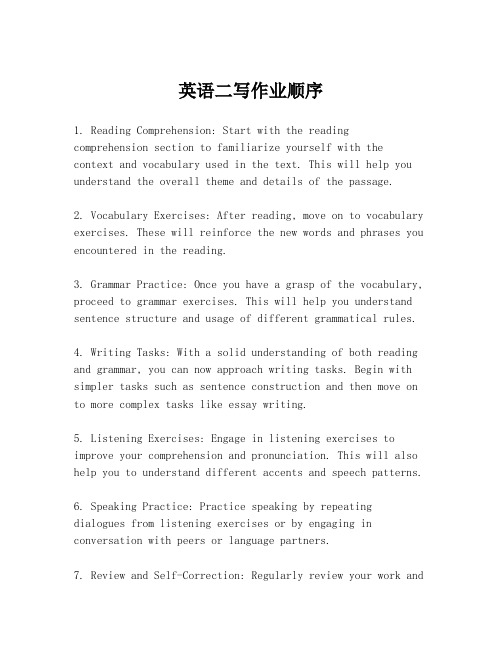
英语二写作业顺序1. Reading Comprehension: Start with the reading comprehension section to familiarize yourself with the context and vocabulary used in the text. This will help you understand the overall theme and details of the passage.2. Vocabulary Exercises: After reading, move on to vocabulary exercises. These will reinforce the new words and phrases you encountered in the reading.3. Grammar Practice: Once you have a grasp of the vocabulary, proceed to grammar exercises. This will help you understand sentence structure and usage of different grammatical rules.4. Writing Tasks: With a solid understanding of both reading and grammar, you can now approach writing tasks. Begin with simpler tasks such as sentence construction and then move on to more complex tasks like essay writing.5. Listening Exercises: Engage in listening exercises to improve your comprehension and pronunciation. This will also help you to understand different accents and speech patterns.6. Speaking Practice: Practice speaking by repeating dialogues from listening exercises or by engaging in conversation with peers or language partners.7. Review and Self-Correction: Regularly review your work andcompare it with the provided answers or model responses. This will help you identify areas for improvement.8. Quiz and Tests: Finally, take quizzes and tests to evaluate your understanding and retention of the material covered.Remember, consistency and practice are key to improving your English skills. Make sure to allocate time for each of these tasks and gradually increase the complexity as you progress.。
家长应该给孩子批改作业为主题的英语作文
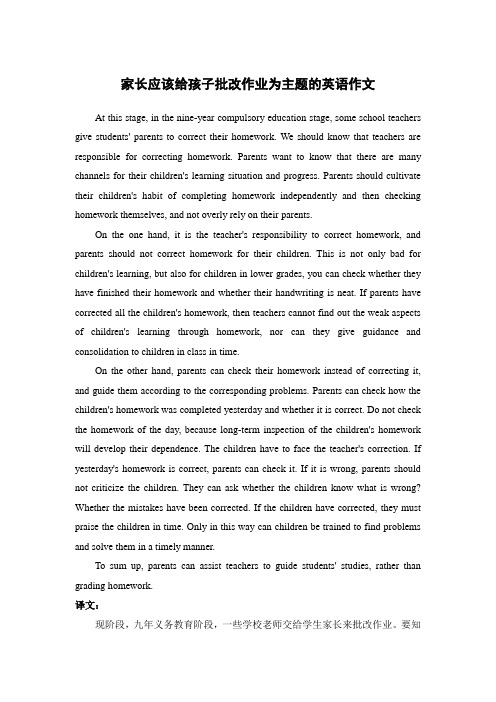
家长应该给孩子批改作业为主题的英语作文At this stage, in the nine-year compulsory education stage, some school teachers give students' parents to correct their homework. We should know that teachers are responsible for correcting homework. Parents want to know that there are many channels for their children's learning situation and progress. Parents should cultivate their children's habit of completing homework independently and then checking homework themselves, and not overly rely on their parents.On the one hand, it is the teacher's responsibility to correct homework, and parents should not correct homework for their children. This is not only bad for children's learning, but also for children in lower grades, you can check whether they have finished their homework and whether their handwriting is neat. If parents have corrected all the children's homework, then teachers cannot find out the weak aspects of children's learning through homework, nor can they give guidance and consolidation to children in class in time.On the other hand, parents can check their homework instead of correcting it, and guide them according to the corresponding problems. Parents can check how the children's homework was completed yesterday and whether it is correct. Do not check the homework of the day, because long-term inspection of the children's homework will develop their dependence. The children have to face the teacher's correction. If yesterday's homework is correct, parents can check it. If it is wrong, parents should not criticize the children. They can ask whether the children know what is wrong? Whether the mistakes have been corrected. If the children have corrected, they must praise the children in time. Only in this way can children be trained to find problems and solve them in a timely manner.To sum up, parents can assist teachers to guide students' studies, rather than grading homework.译文:现阶段,九年义务教育阶段,一些学校老师交给学生家长来批改作业。
昨天我在家写作业英语

昨天我在家写作业英语Yesterday, I spent the entire afternoon at home working on my English homework. It was a mix of reading comprehension, vocabulary exercises, and writing practice. Here's a brief overview of what I did:1. Reading Comprehension: I started with a passage about the history of the English language. It was quite interesting to learn how the language has evolved over centuries. I had to answer several questions about the main ideas and details within the text.2. Vocabulary Exercises: Next, I tackled a set of vocabulary exercises. These included matching words to their definitions, creating sentences using new words, and identifying synonyms and antonyms. It was a great way to expand my vocabulary and understand the nuances of different words.3. Grammar Practice: I then moved on to grammar exercises.The focus was on verb tenses, specifically the past perfect and past continuous tenses. I practiced changing sentencesfrom one tense to another and identifying the correct tensein given sentences.4. Writing Practice: The final part of my homework was awriting assignment. I had to write a short essay on "The Benefits of Learning a Second Language." I discussed how it can enhance cognitive abilities, improve job prospects, andfoster cultural understanding.5. Review and Self-Correction: After completing all the tasks,I reviewed my work and corrected any mistakes I found. I also used online resources to check the accuracy of my answers and to learn more about the topics I was unsure about.I found the homework quite challenging but also very rewarding. It helped me improve my English skills and deepened my understanding of the language.。
作业批改改进措施英语作文
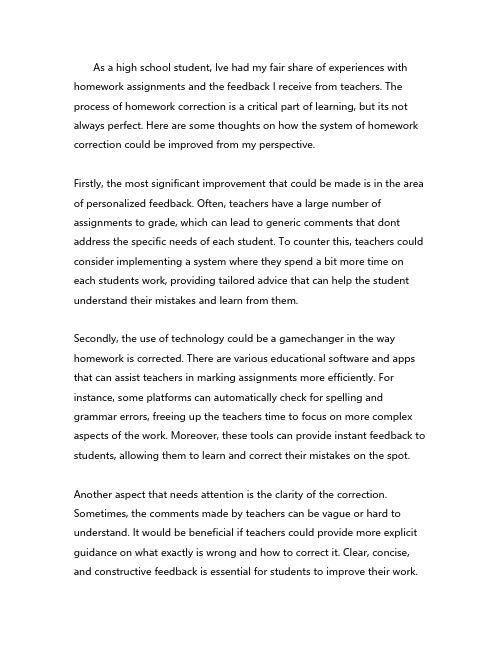
As a high school student, Ive had my fair share of experiences with homework assignments and the feedback I receive from teachers. The process of homework correction is a critical part of learning, but its not always perfect. Here are some thoughts on how the system of homework correction could be improved from my perspective.Firstly, the most significant improvement that could be made is in the area of personalized feedback. Often, teachers have a large number of assignments to grade, which can lead to generic comments that dont address the specific needs of each student. To counter this, teachers could consider implementing a system where they spend a bit more time on each students work, providing tailored advice that can help the student understand their mistakes and learn from them.Secondly, the use of technology could be a gamechanger in the way homework is corrected. There are various educational software and apps that can assist teachers in marking assignments more efficiently. For instance, some platforms can automatically check for spelling and grammar errors, freeing up the teachers time to focus on more complex aspects of the work. Moreover, these tools can provide instant feedback to students, allowing them to learn and correct their mistakes on the spot.Another aspect that needs attention is the clarity of the correction. Sometimes, the comments made by teachers can be vague or hard to understand. It would be beneficial if teachers could provide more explicit guidance on what exactly is wrong and how to correct it. Clear, concise, and constructive feedback is essential for students to improve their work.Furthermore, incorporating a peer review system could be a valuable addition to the homework correction process. By allowing students to review and comment on each others work, they can learn from their peers perspectives and gain a broader understanding of the subject matter. This not only enhances learning but also fosters a sense of community and collaboration among students.In addition, its important to recognize the emotional aspect of homework correction. Receiving negative feedback can be disheartening for students. Teachers could consider using a more positive approach, focusing on the students strengths and progress, while gently guiding them towards improvement. This can boost students confidence and motivate them to work harder.Lastly, regular workshops or seminars on effective homework correction techniques for teachers could be beneficial. This would ensure that teachers are uptodate with the latest pedagogical methods and can apply them in their teaching practices.In conclusion, the homework correction process is a vital component of the educational system, and there is always room for improvement. By personalizing feedback, leveraging technology, ensuring clarity, incorporating peer reviews, maintaining a positive approach, and providing continuous professional development for teachers, we can enhance the effectiveness of homework correction and, ultimately, the learning experience for students.。
课下认真写作业英语
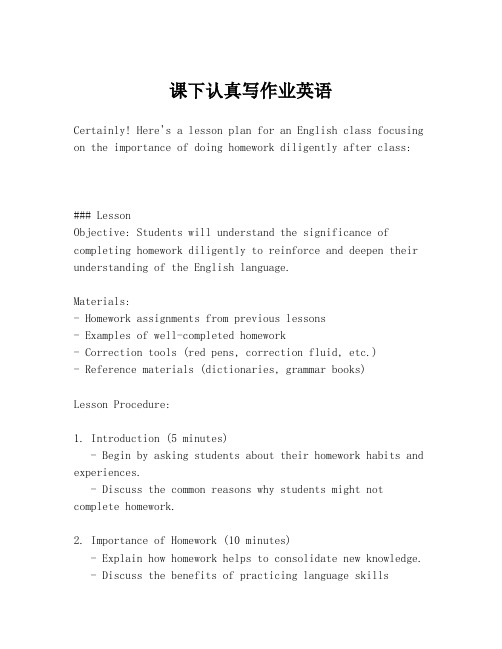
课下认真写作业英语Certainly! Here's a lesson plan for an English class focusing on the importance of doing homework diligently after class:### LessonObjective: Students will understand the significance of completing homework diligently to reinforce and deepen their understanding of the English language.Materials:- Homework assignments from previous lessons- Examples of well-completed homework- Correction tools (red pens, correction fluid, etc.)- Reference materials (dictionaries, grammar books)Lesson Procedure:1. Introduction (5 minutes)- Begin by asking students about their homework habits and experiences.- Discuss the common reasons why students might not complete homework.2. Importance of Homework (10 minutes)- Explain how homework helps to consolidate new knowledge. - Discuss the benefits of practicing language skillsoutside the classroom.- Highlight how homework can lead to better grades and understanding.3. Review of Previous Homework (15 minutes)- Review a sample of the previous homework.- Discuss common mistakes and how to avoid them.- Use the well-completed homework as a model for discussion.4. Strategies for Effective Homework (15 minutes)- Teach students how to set aside time for homework.- Introduce techniques for breaking down complex tasks. - Discuss the use of reference materials and seeking help when needed.5. Interactive Activity (15 minutes)- Divide students into small groups.- Assign a short, focused homework task that requires collaboration.- Have each group present their approach and findings.6. Reflection and Feedback (10 minutes)- Allow students to reflect on their homework habits.- Provide feedback on the interactive activity.- Discuss any difficulties students face and brainstorm solutions.7. Conclusion (5 minutes)- Summarize the key points of the lesson.- Reiterate the importance of doing homework diligently.- Encourage students to apply the strategies discussed in their future homework.Homework Assignment:- Students are to complete a new set of exercises designed to reinforce today's lesson.- Include a short reflection on their homework process and any challenges they anticipate.Assessment:- Monitor the quality of the homework submitted in the next class.- Provide individual feedback to help students improve their homework habits.This lesson plan is designed to help students understand the value of doing homework and to equip them with strategies to do it effectively.。
第二件事写作业英语怎么说
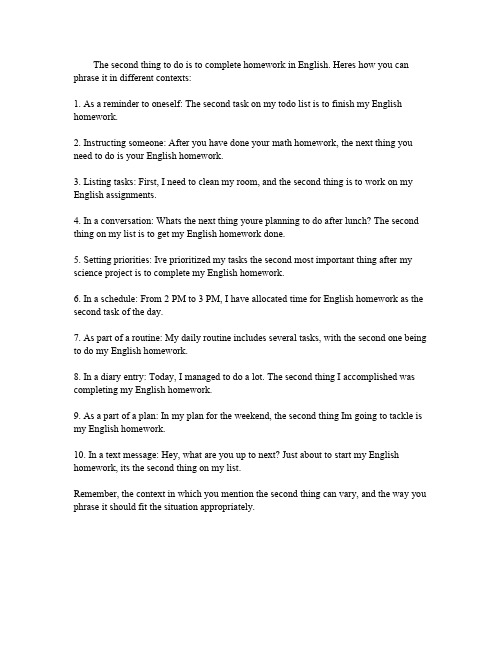
The second thing to do is to complete homework in English.Heres how you can phrase it in different contexts:1.As a reminder to oneself:The second task on my todo list is to finish my English homework.2.Instructing someone:After you have done your math homework,the next thing you need to do is your English homework.3.Listing tasks:First,I need to clean my room,and the second thing is to work on my English assignments.4.In a conversation:Whats the next thing youre planning to do after lunch?The second thing on my list is to get my English homework done.5.Setting priorities:Ive prioritized my tasks the second most important thing after my science project is to complete my English homework.6.In a schedule:From2PM to3PM,I have allocated time for English homework as the second task of the day.7.As part of a routine:My daily routine includes several tasks,with the second one being to do my English homework.8.In a diary entry:Today,I managed to do a lot.The second thing I accomplished was completing my English homework.9.As a part of a plan:In my plan for the weekend,the second thing Im going to tackle is my English homework.10.In a text message:Hey,what are you up to next?Just about to start my English homework,its the second thing on my list.Remember,the context in which you mention the second thing can vary,and the way you phrase it should fit the situation appropriately.。
英语改作业的简报范文
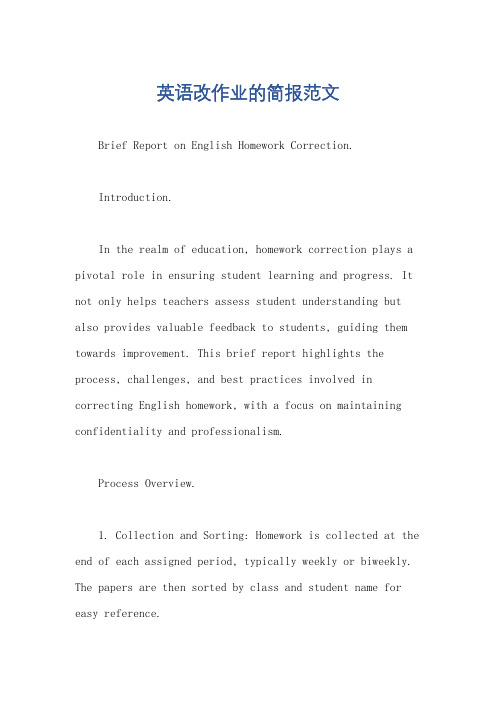
英语改作业的简报范文Brief Report on English Homework Correction.Introduction.In the realm of education, homework correction plays a pivotal role in ensuring student learning and progress. It not only helps teachers assess student understanding but also provides valuable feedback to students, guiding them towards improvement. This brief report highlights the process, challenges, and best practices involved in correcting English homework, with a focus on maintaining confidentiality and professionalism.Process Overview.1. Collection and Sorting: Homework is collected at the end of each assigned period, typically weekly or biweekly. The papers are then sorted by class and student name for easy reference.2. Initial Screening: A quick scan of each paper isdone to identify any major issues or common mistakes, such as grammatical errors, spelling mistakes, or incoherent sentences.3. Detailed Correction: Each paper is then carefully corrected, noting down specific errors and offering suggestions for improvement. Comments on content, structure, and language use are also provided.4. Recording Grades: After correction, grades are assigned based on various criteria such as accuracy, creativity, and effort shown.5. Feedback Delivery: Corrected homework with detailed feedback is returned to students promptly, either in person or through a designated online platform.Challenges Faced.1. Diversity in Student Abilities: Correcting homeworkfor students with varying levels of English proficiency can be challenging, as each requires a tailored approach.2. Maintaining Consistency: Ensuring that feedback is consistent across all students and assignments can be difficult, especially when dealing with a large number of papers.3. Time Constraints: With limited time available for correction, it can be challenging to provide detailed feedback while also ensuring timely delivery of corrected homework.Best Practices.1. Standardized Rubric: Using a standardized rubric for grading helps maintain consistency and fairness in evaluation.2. Clear and Constructive Feedback: Providing clear and constructive feedback is essential for guiding students towards improvement. Comments should focus on both contentand language use.3. Encouraging Student Engagement: Homework correction should not just be about identifying errors; it should also serve to encourage students to engage with the material and improve their skills.4. Efficient Organization: Implementing effective organizational systems, such as using digital tools for sorting and grading, can help streamline the correction process and save time.Conclusion.Correcting English homework is an integral part of the teaching-learning process, requiring both attention to detail and a commitment to student success. By following best practices and overcoming challenges, teachers can ensure that homework correction not only serves its purpose but also enhances the learning experience for students. By maintaining professionalism and confidentiality throughoutthe process, teachers contribute to a positive and supportive learning environment.。
关于是否取消家庭作业的英语作文简单
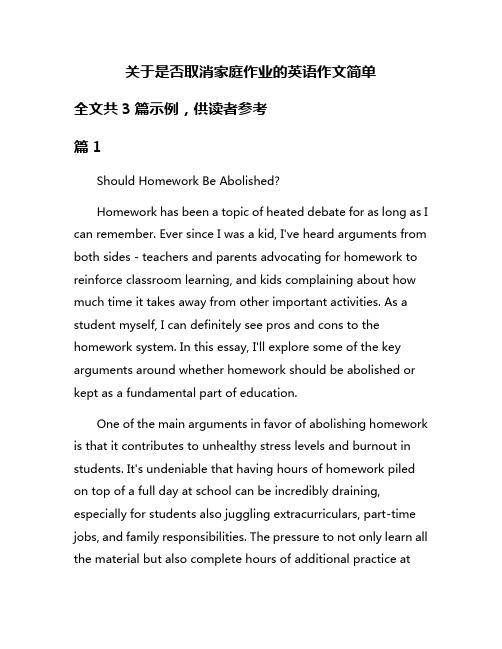
关于是否取消家庭作业的英语作文简单全文共3篇示例,供读者参考篇1Should Homework Be Abolished?Homework has been a topic of heated debate for as long as I can remember. Ever since I was a kid, I've heard arguments from both sides - teachers and parents advocating for homework to reinforce classroom learning, and kids complaining about how much time it takes away from other important activities. As a student myself, I can definitely see pros and cons to the homework system. In this essay, I'll explore some of the key arguments around whether homework should be abolished or kept as a fundamental part of education.One of the main arguments in favor of abolishing homework is that it contributes to unhealthy stress levels and burnout in students. It's undeniable that having hours of homework piled on top of a full day at school can be incredibly draining, especially for students also juggling extracurriculars, part-time jobs, and family responsibilities. The pressure to not only learn all the material but also complete hours of additional practice athome has led many students to forgo adequate sleep, exercise, and free time - essentials for physical and mental health. Excessive homework has been linked to higher rates of anxiety, depression, and other wellness issues in young people. Supporters of abolishing homework argue that removing this major source of strain would significantly improve student wellbeing.Additionally, homework policies often disproportionately disadvantage students from lower-income families. While affluent families may have the time, resources, and home environments conducive to focused homework completion, students in poverty face obstacles like overcrowded homes, lack of internet access, and absence of parent availability due to working multiple jobs. Children raised in unstable or crisis situations may not have the privilege of homework being their top priority. Eliminating mandatory homework, it's argued, would level the playing field and remove one systemic barrier to equitable education.From a pedagogical standpoint, however, there are reasons why homework should be maintained as part of the learning process. The ability to independently practice, apply, and reinforce concepts learned in class is crucial for solidifyingunderstanding and developing critical thinking skills. Regular homework allows students to identify gaps in their knowledge and seek extra support, while also building vital traits like time management and self-discipline. Homework positions students to take more ownership over their learning through active recall and self-guided practice, rather than just passive content consumption in the classroom.Moreover, many core subjects like math, science, and languages require substantial practice outside of class time to master skills and content. Some educators argue that without homework, classroom hours alone wouldn't provide sufficient time-on-task for students to grasp complex or challenging concepts. Homework allows students to repeatedly revisit topics and continuously strengthen their comprehension over time. In this view, abolishing homework could be detrimental to academic performance and skills mastery.That said, in my opinion, the quality and quantity of homework assigned is where reform needs to happen, not complete abolition. Too much homework can certainly do more harm than good in terms of student stress and work-life balance. But the solution may be smarter homework policies and instructional approaches, not doing away with it entirely.Firstly, homework needs to be purposeful and aligned with clearly articulated learning objectives - not just busywork for the sake of assigning something. Each assignment should have a direct tie-back to instructional priorities and provide opportunities for students to practice essential skills. Frivolous or redundant homework isn't beneficial and should be eliminated. Teachers should also have maximum time limits and workload calculators for nightly assignments based on student age and course difficulty.Secondly, homework shouldn't merely be rote repetition or memorization of content. While judicious practice is important, assignments should emphasize higher-order thinking skills like analysis, application of concepts to new scenarios, synthesis of ideas across multiple units, and other engaging cognitive tasks. More creative, exploratory, and project-based homework assignments could make the work more rewarding and motivating for students.Differentiated homework is also key; not every student should receive the exact same assignment. Teachers can provide enrichment opportunities or modified tasks based on students' varying levels of proficiency and educational needs. Those already proficient in certain areas could apply their skills in novelways through extended projects, while students needing more foundational support get targeted practice and scaffolding.Greater involvement of parents and communities in the homework process, within reason, may be beneficial too. For families interested in being more engaged, having insight into curricular learning goals and upcoming assignments allows them to provide supportive environments and supplemental enrichment activities at home. Parent-teacher communication channels regarding homework policies, guidelines, and feedback loops are important for creating a collaborative system.Lastly, more competency-based homework models could reduce redundancy. Rather than assigning a batch of practice every night, curricula and homework can be personalized - letting students work through content at their own pace, while having the flexibility to move ahead in areas of strength and dedicate more time to topics they need extra practice in. This mastery-based approach prevents stalling or excessive repetition of grasped concepts.Overall, I believe thoughtful implementation of quality homework as one component of a holistic educational framework is important for student learning and development. But the current homework status quo at many schools could useimprovement. Excessive volumes of drill-and-kill busywork are misguided, but completely abolishing homework would also be an overcorrection that discards its substantive learning benefits. The path forward is better regulation of homework policies, along with diversification and personalization of homework practices. When homework is purposeful, efficient, and balanced, it serves as a valuable tool for student growth and achievement. But when it's indiscriminate and overly burdensome, homework defeats its own purpose. With some common-sense reforms, I think we can find a better middle ground that maximizes the pros and minimizes the cons of homework.篇2Should Homework Be Abolished?Homework has been a constant in the lives of students for as long as anyone can remember. But in recent years, there has been a growing debate around whether it actually benefits students or if it should be abolished altogether. As a student myself, I can certainly see arguments on both sides.On one hand, homework allows students to practice and reinforce the concepts learned in class. It gives us an opportunity to apply the knowledge we've gained and solidify ourunderstanding. Additionally, homework helps develop important skills like time management, discipline, and independent learning – skills that will be invaluable in our future academic and professional lives.However, the flip side is that homework can also be a significant source of stress and anxiety for many students. The sheer volume of assignments coupled with the pressure to excel can lead to burnout and negatively impact our mental health. Not to mention, homework often eats into our free time, leaving little room for extracurricular activities, hobbies, andmuch-needed rest.Personally, I don't think homework should be completely abolished, but I do believe there needs to be a better balance. Teachers should be more mindful of the workload they're assigning and ensure that it's truly beneficial and not just busy work. Perhaps a more reasonable approach would be to assign homework only for specific subjects or on certain days, allowing students to catch a breather.Another potential solution could be to incorporate more project-based or interactive assignments that make learning feel less like a chore and more like an engaging experience. Thesetypes of assignments could even involve teamwork, fostering collaboration and communication skills.Of course, any changes to the homework system would require a concerted effort from educators, parents, and students alike. Teachers would need to reevaluate their approach to assignments, parents would need to be supportive and understanding of the changes, and students would need to take responsibility for their learning and make the most of the opportunities provided.Ultimately, the goal should be to strike a balance that promotes learning and growth without overburdening students. Homework should be a tool to reinforce concepts, not a source of unnecessary stress and anxiety.As a student, I can attest to the fact that homework can be both beneficial and burdensome. While it serves an important purpose, the current system often feels like a one-size-fits-all approach that doesn't take into account individual student needs and circumstances.Perhaps a more personalized approach, where homework is tailored to each student's strengths, weaknesses, and learning styles, could be more effective. This way, students who struggle with a particular concept can receive additional practice, whilethose who have already mastered it can move on to more challenging material.Another potential solution could be to incorporate more technology into homework assignments. Interactive online platforms and educational apps could make learning more engaging and accessible, allowing students to progress at their own pace and receive instant feedback.Of course, any changes to the homework system would also need to address issues of equity and access. Not all students have the same resources or support systems at home, and it's important to ensure that any new approach doesn't inadvertently disadvantage certain groups of students.In the end, the homework debate is a complex one, with valid arguments on both sides. While it's clear that some changes are needed to make homework more effective and less burdensome, abolishing it entirely may not be the answer.Instead, perhaps a more balanced and personalized approach, one that takes into account individual student needs and leverages technology and innovative teaching methods, could be the way forward. By working together – educators, parents, and students – we can create a homework system thattruly supports learning and growth without sacrificing thewell-being of our students.篇3Should Homework Be Abolished? A Student's PerspectiveHomework has been a part of the educational experience for as long as any of us can remember. Every day after school, kids hurry home, grab a snack, and then crack open their books to spend hours slaving away on tedious assignments. But is this constant deluge of homework actually beneficial, or is it an outdated practice that does more harm than good? As a student who has been drowning in homework for years, I have some strong opinions on the matter.From a young age, we're taught that homework is necessary to reinforce the lessons learned in class and develop critical thinking skills. The idea is that the extra practice solidifies our understanding of core concepts. Additionally, homework is seen as a way to teach time management, personal responsibility, and discipline. By having to juggle assignments from multiple classes with other extracurricular activities and responsibilities, the argument goes that we learn invaluable organizational skills that will serve us well in the real world.However, I would argue that in reality, homework often has the opposite effect. Instead of promoting a love of learning, it breeds resentment towards school and academics. Spending hours every night grinding through an endless list of busywork assignments is soul-crushing. The sheer volume of homework frequently assigned can quickly lead to burnout, exhaustion, and decreased motivation.From personal experience, I know that there have been countless nights where I've stayed up well past midnight, struggling to concentrate as I force myself to finish yet another mindless worksheet or reading assignment. By the time I finally crawl into bed, I'm so mentally drained that it's difficult to get sufficient sleep to be able to function properly the next day. This constant fatigue makes it harder to retain information and be engaged during class, which then leads to even more homework being assigned to "catch me up." It's a vicious, counterproductive cycle.The stress and anxiety caused by excessive homework is also detrimental to our well-being. With so many assignments piling up and strict deadlines to meet, it's easy to become overwhelmed. This can exacerbate issues like depression and anxiety disorders. Childhood and adolescence are alreadyturbulent enough without the added pressure of having to forfeit any semblance of a life outside of academics. We should be spending time with friends and family, exercising, pursuing hobbies and extracurriculars, and just being kids. Instead, many of us have our childhoods stolen away as we're forced to devote every waking hour to homework.Not only is this constant grind terrible for our mental health, but it could also be argued that it doesn't actually lead to improved academic performance. Studies have found that there is no correlation between excessive homework and better grades or test scores. In fact, too much homework can lead to diminishing returns as students become frustrated, disengaged, and simply resort to mindless completion of assignments rather than actually learning and understanding the material.Homework certainly has its place in moderation, but the sheer volume being piled on students these days is unnecessary and actively harmful. A few targeted assignments to solidify major concepts is reasonable, but the endless barrage of worksheets, busywork, and lengthy projects needs to stop. We're killing students' love of learning and passion for academics before they've even had a chance to blossom.Perhaps homework policies need to be adjusted based on research into optimal workloads for different age groups. Or maybe the entire homework model needs an overhaul, with more of an emphasis on hands-on, experiential learning both in and out of the classroom. At the very least, there needs to be far better coordination between teachers to ensure students don't end up overwhelmed by simultaneous large assignments from multiple classes.Ultimately, homework is a tool that should serve to enhance and enrich the educational experience, not make kids'。
居家学习坚持的一件事英语作文
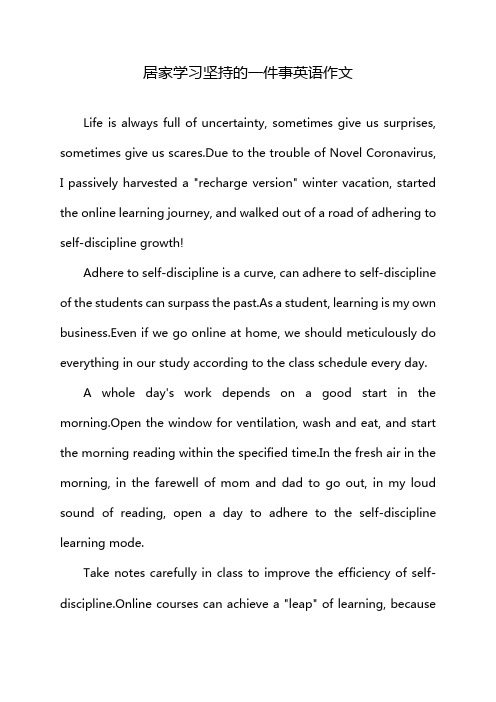
居家学习坚持的一件事英语作文Life is always full of uncertainty, sometimes give us surprises, sometimes give us scares.Due to the trouble of Novel Coronavirus, I passively harvested a "recharge version" winter vacation, started the online learning journey, and walked out of a road of adhering to self-discipline growth!Adhere to self-discipline is a curve, can adhere to self-discipline of the students can surpass the past.As a student, learning is my own business.Even if we go online at home, we should meticulously do everything in our study according to the class schedule every day.A whole day's work depends on a good start in the morning.Open the window for ventilation, wash and eat, and start the morning reading within the specified time.In the fresh air in the morning, in the farewell of mom and dad to go out, in my loud sound of reading, open a day to adhere to the self-discipline learning mode.Take notes carefully in class to improve the efficiency of self-discipline.Online courses can achieve a "leap" of learning, becausewe can encounter questions to listen to again, important knowledge points can also press the pause button to take notes.I found that taking good notes carefully in class can not only help me to pay all my attention, but also involuntarily follow the rhythm of the teacher's class, play my imagination, and integrate into the beautiful scenery described by the teacher."Country people" that lesson, when the teacher vividly talked about the "moonlight dream map", I seem to see a child grandmother sing lullaby with me to fall asleep scene.Do homework carefully after class, and consolidate the achievements of self-discipline learning.After each class, the teachers of the school will post their homework in class in time, which is the best process of self-examination and consolidation and improvement.Before doing your homework, carefully read the homework of the day and plan a completion time.This is very important, can let me clear my goals and plans in mind, improve the efficiency of homework.Finish the homework to timely correction and correction, correction homework can not cut corners, perfunctory, must make the problem thoroughly, know where theyare wrong, to avoid making the same mistake in the future!Nagai wind once said "yesterday's abyss, today's shallow talk".Adhere to self-discipline is the wings, is also the best life armor.This busy and fulfilling online course journey makes me adhere to self-discipline, with me to grow up!生活总是充满了不确定性,有时给我们的是惊喜,有时给我们的是惊吓。
二次备课的英语作文
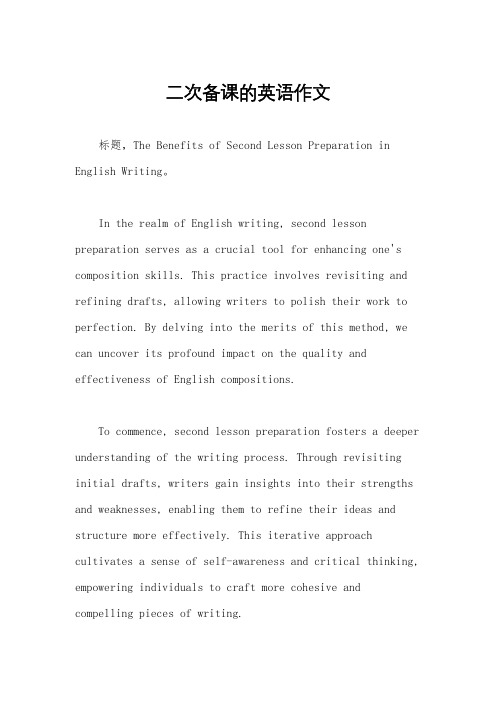
二次备课的英语作文标题,The Benefits of Second Lesson Preparation in English Writing。
In the realm of English writing, second lesson preparation serves as a crucial tool for enhancing one's composition skills. This practice involves revisiting and refining drafts, allowing writers to polish their work to perfection. By delving into the merits of this method, we can uncover its profound impact on the quality and effectiveness of English compositions.To commence, second lesson preparation fosters a deeper understanding of the writing process. Through revisiting initial drafts, writers gain insights into their strengths and weaknesses, enabling them to refine their ideas and structure more effectively. This iterative approach cultivates a sense of self-awareness and critical thinking, empowering individuals to craft more cohesive and compelling pieces of writing.Moreover, second lesson preparation facilitates the development of essential writing skills. By revising drafts, writers hone their proficiency in grammar, vocabulary, and sentence structure. This meticulous attention to detail not only enhances the clarity and coherence of their compositions but also instills a sense of linguisticfluency and precision. Consequently, writers become more adept at articulating their thoughts and conveying their message with clarity and eloquence.Furthermore, second lesson preparation encourages creativity and innovation in writing. As writers revisit their drafts, they are prompted to explore alternative ideas, perspectives, and stylistic choices. This iterative process of experimentation and refinement fosters a culture of creativity, allowing writers to break free from conventional norms and conventions. By embracing novel approaches and techniques, individuals can imbue their writing with freshness and originality, captivating readers and leaving a lasting impression.Additionally, second lesson preparation promotes resilience and perseverance in the face of challenges. Writing is a complex and demanding task that often requires multiple iterations and revisions to achieve perfection. Through the process of refining their drafts, writers encounter setbacks and obstacles that test their resolve and determination. However, by persisting in their efforts and learning from their mistakes, individuals emerge stronger and more resilient, equipped with the skills and tenacity to overcome future challenges.Furthermore, second lesson preparation cultivates a culture of continuous improvement and lifelong learning. By revisiting their drafts, writers demonstrate a commitment to excellence and a willingness to embrace feedback and constructive criticism. This reflective practice enables individuals to identify areas for growth and development, setting new goals and striving towards self-improvement. In doing so, writers embark on a journey of lifelong learning, continually refining their craft and expanding their horizons.In conclusion, second lesson preparation is a valuable and indispensable tool for enhancing English writing skills. By fostering a deeper understanding of the writing process, honing essential writing skills, encouraging creativity and innovation, promoting resilience and perseverance, and cultivating a culture of continuous improvement, this practice empowers writers to unleash their full potential and produce compositions of unparalleled quality and effectiveness. As such, second lesson preparation should be embraced and celebrated as a cornerstone of excellence in English writing.。
01 双减政策与课后延时服务 2022年中考英语满分作文赏析
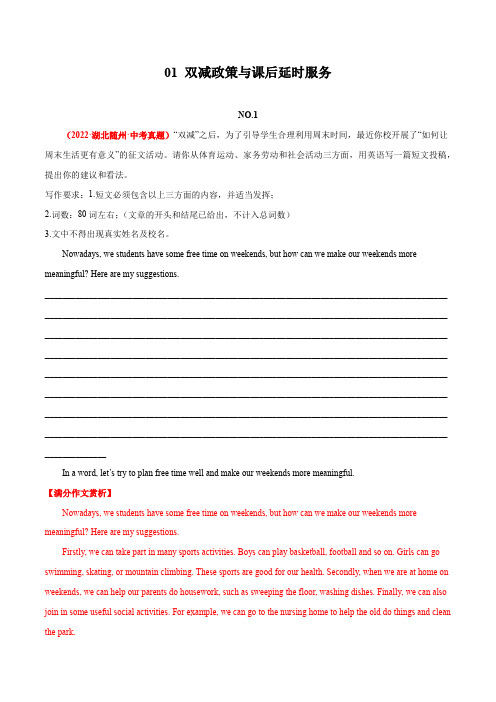
01 双减政策与课后延时服务NO.1(2022·湖北随州·中考真题)“双减”之后,为了引导学生合理利用周末时间,最近你校开展了“如何让周末生活更有意义”的征文活动。
请你从体育运动、家务劳动和社会活动三方面,用英语写一篇短文投稿,提出你的建议和看法。
写作要求:1.短文必须包含以上三方面的内容,并适当发挥;2.词数:80词左右;(文章的开头和结尾已给出,不计入总词数)3.文中不得出现真实姓名及校名。
Nowadays, we students have some free time on weekends, but how can we make our weekends more meaningful? Here are my suggestions.____________________________________________________________________________________________ ____________________________________________________________________________________________ ____________________________________________________________________________________________ ____________________________________________________________________________________________ ____________________________________________________________________________________________ ____________________________________________________________________________________________ ____________________________________________________________________________________________ ____________________________________________________________________________________________ ______________In a word, let’s try to plan free time well and make our weekends more meaningful.【满分作文赏析】Nowadays, we students have some free time on weekends, but how can we make our weekends more meaningful? Here are my suggestions.Firstly, we can take part in many sports activities. Boys can play basketball, football and so on. Girls can go swimming, skating, or mountain climbing. These sports are good for our health. Secondly, when we are at home on weekends, we can help our parents do housework, such as sweeping the floor, washing dishes. Finally, we can also join in some useful social activities. For example, we can go to the nursing home to help the old do things and clean the park.In a word, let’s try to plan free time well and make our weekends more meaningful.【解析】1.题干解读:本文是一篇材料作文,从体育运动、家务劳动和社会活动三方面写一篇作文关于如何让周末生活更有意义。
怎样解决功课不好的初二英语作文
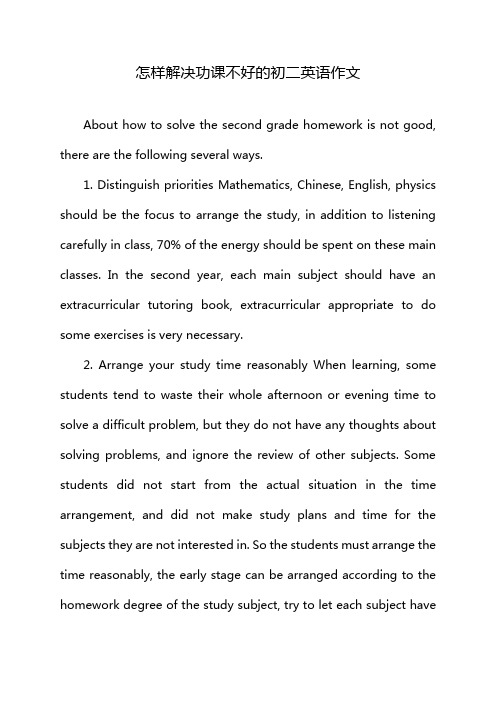
怎样解决功课不好的初二英语作文About how to solve the second grade homework is not good, there are the following several ways.1. Distinguish priorities Mathematics, Chinese, English, physics should be the focus to arrange the study, in addition to listening carefully in class, 70% of the energy should be spent on these main classes. In the second year, each main subject should have an extracurricular tutoring book, extracurricular appropriate to do some exercises is very necessary.2. Arrange your study time reasonably When learning, some students tend to waste their whole afternoon or evening time to solve a difficult problem, but they do not have any thoughts about solving problems, and ignore the review of other subjects. Some students did not start from the actual situation in the time arrangement, and did not make study plans and time for the subjects they are not interested in. So the students must arrange the time reasonably, the early stage can be arranged according to the homework degree of the study subject, try to let each subject havetime to complete. When learning, we should cross-review the arts and sciences, recite before going to bed during the day and at night, remember the knowledge points of liberal arts, review the knowledge points at the end of the day, and consolidate the memory in time.3. Test your own shortcomings and improve them If the model test is not very ideal, it is also a good thing, because you can see a lot of your own shortcomings. Model test is actually a test ground, you can try different test strategies, doing the test methods (such as different writing methods, different reading methods in English, etc.), and find the best one for you.4. Check the missing knowledge points in time The study course of the second grade, compared with the content of the first grade will be more difficult, and there will be new physics subjects. So the students in the initial study, must listen carefully, do not understand the problem or vague knowledge points, must be solved in class or after class, know the overall idea of the answer, and then through doing the problem to consolidate the knowledge points, can not muddle along. To prepare for the future examination!。
你在家做作业有什么意见英语作文

你在家做作业有什么意见英语作文I'm the parent of a student. In this school, I'd like to say a few words from my heart to the teacher. Please forgive me for any mistakes. As parents, we all hope to meet good teachers, but some teachers are really disappointing. For example, some teachers are like this (please don't sit in the right seat, I'm just talking about individual ones, I just hope it's not some):One: there is little communication between teachers and parents.To educate good children, a large part should be supported by parents, and communication between family and school is very important. Some teachers should make some home visits from time to time, or the teacher should inform the parents to gather their parents together on a weekend to communicate with each other, so as to timely reflect some of their children's situation at school to parents, so that parents can know their children's performance at school and communicate with each other at home and school.Second, teachers lack enthusiasm and patience for students.Everyone is advocating "three hearts" (love, patience and sense of responsibility). At present, teachers only have basic salary, but no other subsidies. Some teachers are oppressed by their lives, and they secretly get some tutoring and then leave after class. They have no patience in the past, and they are especially impatient in giving guidance to poor students' wrong homework, giving serious explanations and being kind.Third, the assignment is not scientific enough and the correction is not timely enough.Homework is to better consolidate the knowledge learned that day. If students are asked to write and memorize mechanically, students will be unwilling to do it and will not achieve the purpose of homework. This often causes individual students to get tired of doing homework, and they will not finish their homework in the long run. Therefore, it should be interesting to ask teachers to assign homework, so that students feel that doing homework is an interesting thing. There are not many homework, but they are studying hard, and some of them do their homework until 12 o'clock in the evening. Do you think it's the time when teenagers grow upand don't get enough sleep, so they will have the spirit to study the next day? What's the point of studying at night? 40 minutes in the important class, as long as the teacher talks about learning to understand.。
- 1、下载文档前请自行甄别文档内容的完整性,平台不提供额外的编辑、内容补充、找答案等附加服务。
- 2、"仅部分预览"的文档,不可在线预览部分如存在完整性等问题,可反馈申请退款(可完整预览的文档不适用该条件!)。
- 3、如文档侵犯您的权益,请联系客服反馈,我们会尽快为您处理(人工客服工作时间:9:00-18:30)。
Gradua¸c˜a o em Ciˆe ncia da Computa¸c˜a o DCC/ICEx/UFMG Fundamentos da Teoria da Computa¸c˜a o1semestre de2003 Professor:Newton Jos´e Vieiraemail:nvieira@dcc.ufmg.brSecond Homework-correction1Search in textQuestion1Finite-state automaton(FSA)can be used tofind out if a word belongs to a language.It is natural to use this tool for pattern matching:a string that contains a given pattern belongs to the desired language.The advantages of FSA are multiples.They naturally extend the concept of pattern from a word to an organized structure.A FSA based algorithm for pattern matching do not need to restrict itself to“words that contains this given string”.It can be extended to“words that follow this given structure”.Moreover,the complexity of such an algorithm can be O(n),where n is the size of the text(neglecting the complexity of the generation of the FSA):characters are read one by one by the FSA,and the current state is update.This current state describes the state of the search.If afinal state is reached,the word contains the searched pattern. Question2A non-deterministic FSA that detects words containing ftc is shown onfigure1.Its“determin-istic”version is shown onfigure2.The symbol∗denotes any character of the setΣ\{f,t,c}.Figure1:FSA containing ftcFigure2:Deterministic FSA containing ftcQuestion3A non-deterministic FSA recognizingL={w∈Σ∗||w| 4and w ends with“ftc”}is shown onfigure3Figure3:Non-deterministic FSA recognizing LQuestion4Observation:In the following questions,the symbol#denotes any character ofΣ.An idea to create a non-deterministic FSA recognizing a given word,allowing one substitu-tion is to create a FSA with two levels:thefirst level recognizes the word without error,the second one recognizes the word when a substitution already occurred.Going from thefirst level to the second level is simply done through a transition performing the substitution.As the FSA is non-deterministic,we do not care if a substitution is done with the same character(note that this is not very complicated to obtain a deterministic FSA).Figure4:Non-deterministic FSA recognizing lingua,authorizing one substitutionQuestion5The principle is the same for allowing a deletion.A deletion can be seen as a substitution of a character by an empty character.That is,substituting a character by the characterλ.Figure5:Non-deterministic FSA recognizing lingua,authorizing one deletionQuestion6The principle is the same.We need to be careful to accept an insertion in the beginning of the word.Figure6:Non-deterministic FSA recognizing lingua,authorizing one insertionQuestion7It would be possible to convert all those non-deterministic FSA to deterministic FSA and then generate a deterministic FSA that recognize the union of the languages recognized by the three previous FSA;but this process can be avoided by a sense of observation:the structure of the three previous non-deterministic FSA is very close.This leads us naturally to a non-deterministic FSA that allows one error(substitution,deletion,insertion),by“mixing”all three FSA.Figure7:Non-deterministic FSA recognizing lingua,authorizing one errorQuestion8We use the same idea for generating a non-deterministic FSA recognizing the word abc,allowing an error.Figure8:FSA recognizing abcFigure9:Deterministic FSA recognizing abc2ImplementationA program transforming a given Regular expression(RE)in a deterministic Finite State Au-tomaton has been implemented in C.“The program should work”TM.The source code is available here:http://www.dcc.ufmg.br/∼ghuiban/ftc/tp2.tgz2.1Description of the algorithmThis program implements the Brzozowski algorithm.See[1]for more details on the algorithm.The algorithm uses“derivative”to transform a given RE in a kind of“extended”RE.Each extended RE obtained by the derivation process applied successively will be a state of thefinal deterministic FSA.It has been proved that,from a given RE,the number of different“extended RE”isfinite.This proves that the algorithm will stop.Note that this algorithm converts directly a RE into the corresponding FSA.Moreover,we noticed that our implementation regularly returns the minimum deterministic FSA.2.2Description of the implementationThe source code is divided in threefiles:•main.c:main program•functions.c:contains all functions used for the conversion•header.h:contains the prototype of the functions,the descriptions of used data struc-tures,and some parameters(Number of the character in the alphabet,maximum length for an“extended RE”and maximum number of state of the deterministic FSA.To implement this algorithm,we suppose that the input RE is syntaxically correct.We also consider that the operations are represented:•concatenation:(E.F)•union:(E+F)•Kleen’s closure:(E*)For instance,a valid input is:((((a.b)+b)*).(b.a))Such hypothesis allows us to simplify the analysis of the input RE.The RE is read and transformed into a binary tree.This allows us to extract the structure of the RE,and to simplify the different algorithms,since the structure of the expression is known.The main algorithm is the following:perform a derivation;simplify it;check if the result has already been obtained.If not,create a new state in the resulting FSA.Then,update the transition table.Do this until all states has been treated.The source code is well-documented(we hope).Associated with the reading of[1],it should be quite easy to read it.Some tests have been performed,showing that this program works.If youfind a bug(wrong result,crash,...),please send me a description of the bug and how it happens. References[1]G.Berry and R.Sethi.From regular expressions to deterministic automata.Theoreticalcomputer science,(48):117–126,1986.。
